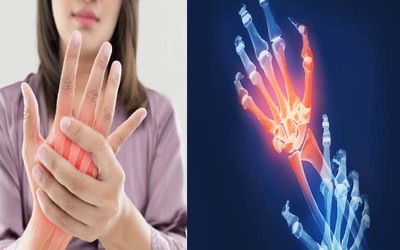Joints are the connections between the bones which help in movement.
[the_ad id=”6114″]They also provide support to the body by bearing weight of the different parts of the body. Joint pain is an extremely common condition. It can affect any part of the body, be it the hands, shoulders, hips, ankles, thighs etc. Joint pain is usually known as Arthritis, where the joints become inflamed because of the decrease in cartilage, a rubbery tissue covering our bones. The bones then rub against each other, which triggers the pain. Joint pain can vary from being mildly painful to a severe, debilitating condition which renders movement impossible.
Arthritis pain depends on the stage of arthritis. In the first stage, the pain predominantly occurs due to certain activities like walking upstairs or on uneven surfaces or squatting or sitting in a cross-legged position. As the condition progresses, the pain is continuous and occurs even during routine activities like walking a few feet. Therefore, it is advised that people who suffer from joint pain for more than two weeks with no history of medical ailments must consult an orthopedic surgeon so that they can be evaluated by clinical examination and X-rays.
Before we go into the symptoms and treatment options, let us have a look at the different types of Arthritis:
1. Osteoarthritis: It is an age-related arthritis which mainly affects the elderly population. But, nowadays it is commonly seen in people as young as in their late forties and early fifties.
2. Inflammatory Arthritis: This includes conditions like rheumatoid arthritis, psoriatic arthritis, systemic lupus erythematosus which predominantly affect the middle-aged and the younger population.
3. There are other forms of arthritis such as crystal induced arthritis, also known as Gouty arthritis. A small population of these involve bacterial arthritis and viral arthritis.
Risk Factors for Arthritis
Certain factors increase the risk of getting arthritis. For instance, the risk of arthritis increases with an increase in age. Conditions such as obesity are also contributing factors. Arthritis is genetic in nature, and is more prevalent amongst women, except for some types such as gout which are more common in males. Injuries and infections in joints can also increase the risk of developing arthritis.
Symptoms of Arthritis
The common signs and symptoms of arthritis are:
- Pain in the joints, which may be constant or intermittent in nature.
- Inflammation of the joints due to stiffness, swelling, which causes the joints to become warm.
- Difficulty in motion and loss of motion
- Tenderness of the inflamed joint
- Fever, weight loss, fatigue and abnormalities of organs such as kidneys, heart etc. in the case of rheumatoid arthritis.
Treatment Options for Arthritis
Although there is no cure, there are many options available for treating arthritis. They are:
Medications : These provide relief from the joint pain by reducing inflammation which is the source of the pain. Over-the-counter medicines like Aspirin, Ibuprofen, Acetaminophen, Tylenol etc. are some of the common medications used. But they may also result in certain side-effects like ulcers and bleeding. Tropical jells can stimulate the sensory nerve endings in the skin and reduce pain signals through the nervous system. Corticosteroids reduce inflammation and suppress the immune system, which particularly addresses the cause of rheumatoid arthritis.
Physical Therapy : Exercise is the best way to relieve arthritis pain and reduce damage to the joints. Low-impact exercises such as stretching, swimming and cycling are recommended because they don’t put pressure on the joints. Aerobics can help improve the stamina and strengthen the heart and the lungs.
Weight loss : People who succeed in reducing their weight experience a reduction in their pain and disability due to arthritis as well. This is because there is now lesser stress on the joints.
Surgery : This is recommended for severe cases when the joints don’t respond to other treatments.
Home Care : The patient can try some simple techniques at home, like cushioning the joint with a brace or a wrap, applying heat and ice packs to ease the inflammation and pain etc.
Do’s and Don’ts of living with Arthritis
In case of osteoarthritis, it is important to keep yourself healthy and fit and keep strengthening the knees so that they are capable of bearing more weight. A healthy diet and lifestyle must be followed. The patient must not squat or sit cross-legged or do deep knee flexion exercises as they cause more wear and tear. They should also not put on more weight as obesity is the most common factor for failure of the knees.
Rheumatoid arthritis mainly affects the young, so the patients should consult an orthopedic surgeon or rheumatologist since early diagnosis can prove to be beneficial in providing a long-term solution.
Other forms of arthritis such as gouty arthritis can be treated by lowering their uric acid levels. Dietary modifications and medications play a very important role in the treatment of crystal-induced arthritis.
In many cases, a combination of therapies can be used to ease the effects of arthritis. The bottom-line is, although there is no cure for this condition, a healthy and active lifestyle can play a major role in warding off this disease.
Source:

